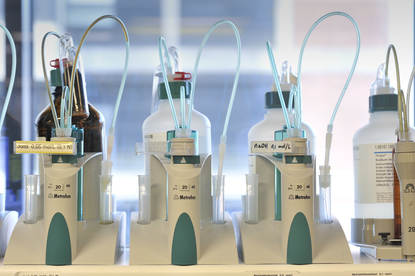Regulatory science provides the Medicines Evaluation Board (MEB) with up-to-date data, knowledge and expertise based on current scientific insights, for optimal evaluation and marketing authorisation of medicinal products and novel foods. This ensures an even better assessment of risks, efficacy and quality.
Research trajectories & programmes
On the MEB website you can find all the research trajectories and programmes the MEB supports.
The MEB’s Regulatory Science definition:
Regulatory Science is the science of developing and validating new standards and tools to evaluate andd assess the benefit/risk of medicinal products, facilitating sound and transparent regulatory decision making. Through analysis of regulatory frameworks itself and its effectiveness, however, Regulatory Science can also advance knowledge of these systems in general.

Thesis Highlight: Désirée Veening-Griffioen
Can animal models predict clinical efficacy?
Promotors: Prof. Huub Schellekens (Utrecht University) and Prof. Ellen Moors (Utrecht University)
Co-promotor: Peter van Meer, PhD (MEB / Utrecht University)
Causes of clinical failure in phase II and III clinical trials are mainly (52%) due to lack of efficacy, which is in part attributed to non-predictive animal models. Across different therapeutic areas, the animal-to-human translational success rate ranges from 0 to 100%, indicating that the translational value is unpredictable. For Alzheimer’s disease the clinical trial failures is more than 99%, and in stark contrast to the positive efficacy data in animals. And although this is specifically known in the field, none of these reviews performed a systematic evaluation of all available animal models for Alzheimer’s disease.
In our recent paper titled 'Are some animal models more equal than other? A case study on the translational value of animal models of efficacy for Alzheimer’s disease', published in the European Journal of Pharmacology[1], we evaluated the correlation between animal and clinical efficacy outcome. We identified the interventions tested in phase II or III clinical trials for Alzheimer’s disease and compared the efficacy outcome (cognition) to their outcomes in the animal models. In 58% of cases, the clinical outcome was correlated with animal results. However, when looking at individual animal models, the correct prediction for clinical outcome was variable within and between interventions, suggesting that each animal model represents, hypothesis based, parts of the disease phenomena. What also made translation more difficult was the use of non-validated methodology to measure outcomes, especially for outcomes such as cognition, behavior or function.
Therefore, investigators, ethical committees and funding bodies should be reminded that, in the way animal models are currently used to test the efficacy of novel drugs in the field of Alzheimer’s disease, these models are not useful to predict clinical efficacy.
How to proceed? The fact that the animal models were poor predictors of clinical efficacy, does probably not apply solely to Alzheimer’s disease, but to any complex disease showing multiple pathologies or phenotypes. Each animal model for a specific (complex) disease then models aspects of the disease and not the disease perse.
Therefore:
- There is an urgent need for validated models (both in vivo and in vitro), in which translational and validated outcomes are measured and animal studies are properly designed and reported.
- To better understand which aspects an animal model is able or not able to simulate of the human disease, and facilitate the comparison between animal models, we recently developed a systematic and standardized method to establish external validity of animal models[2]
- To promote learning, and keep track of what has been achieved in the scientific community, data sharing (e.g. via an online platform) is highly recommended.
Sources
- Veening-Griffioen, D.H., et al., Are some animal models more equal than others? A case study on the translational value of animal models of efficacy for Alzheimer's disease. Eur J Pharmacol, 2019. 859: p. 172524.
- Ferreira, G.S., et al., A standardised framework to identify optimal animal models for efficacy assessment in drug development. PLoS One, 2019. 14(6): p. e0218014.
Also see this article the previous edition of Regulatory Science Magazine.

Thesis Highlight: Nafise Ghalandari
The safety of biopharmaceutical medicines (biologics) during pregnancy/lactation in patients with chronic autoimmune diseases
Promotors: Mieke Hazes (Erasmus Medical Centre) and Eugene van Puijenbroek (Netherlands Pharmacovigilance Centre Lareb)
Co-promotors: Ineke Crijns (Medicines Evaluation Board) and Radboud Dolhain (Erasmus Medical Centre)
Biologics are important medicine for the treatment of chronic disorders. Various chronic conditions begin in adolescence, thereby resulting in the administration of biologics in women of childbearing age. This PhD project focuses on the safety of treatment with biologics during pregnancy/lactation in patients with chronic autoimmune diseases. Usually data on the effects of intrauterine/lactation exposure are only available in animals. As a result, most biological SmPCs (Summary of Product Characteristics) have no information about human use during pregnancy/lactation and this is mostly reported as missing information in the RMP (Risk Management Plan).
The purpose of this PhD trajectory is to gain knowledge about the effects on offspring after exposure during pregnancy / lactation. From a regulatory point of view, this can lead to gain a better perspective about the benefit risk balance of treatment with biologics during pregnancy/lactation and therefore their authorisation/withdrawal for use during pregnancy.
In the first project we investigated and compared pre-marketing and post-marketing data, publicly available at the European Medicines Agency’s (EMA’s) website, on treatment with biologics during pregnancy and lactation. We then inspected the clinical applicability of these data and scored them by specified criteria, based on scientific literature. From 16 investigated biologics, only four fulfilled the criteria as clinically applicable. Some suggestions were discussed regarding optimising amendments in this regard (e.g. precise definition of the minimum data delivered by the marketing authorisation holders about pregnancy/lactation.) These data were recently published in the British Journal of Clinical Pharmacology.
Furthermore, we have conducted a systematic review, to gather the data from different studies on miscarriages and congenital malformations in patients using biologics during pregnancy. In this review we gathered data from 143 publications. Primary results show no higher congenital malformation or abortion rates in offspring exposed to biologics during pregnancy. Currently, this study is under internal review and willbe subsequentely submitted to a journal.
The next planned projects include:
- A study on recognizing patterns of different congenital malformations in pregnancy reports on biologics use in Eudravigilance database (European Union Drug Regulating Authorities Pharmacovigilance database) in collaboration with EMA.
- A pharmacokinetic (PK) study, comparing PK characteristics of biologics during different trimesters.






